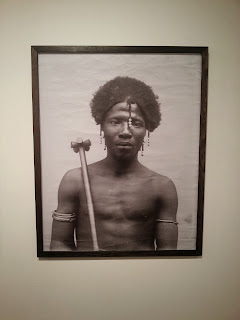For this week, professor Vesna talks about the mind, brain, and memory. She adds how machines work or made with consciousness. What is mean by being conscious? What is brain? To answer this question, people chronically studied and looked for the discoveries of brain system. Franz Joseph Gall is known for illustrating phrenology which individuality, personality, and human behavior depend on the mental function. It can be translated to mind and knowledge.
one example of neuroculture "the brain hat"
While I was glad that I found some fact that I know (it was the brain divided into organs), it was my first time to see the combination of two different professionals' work.
Suzanne Anker, the artist and Giovanni Frazzetto, the neuroscientist began the "neuroculture project". They were both interested in the relationship between art and neuroscience and interconnect their idea to the human's daily life. On the fMRI scans, they show butterfly having identical print on the brain. Such great and artistic activities help us how brain and synapses work.
The article "Neuroculture" also describe how individuality works regarding the neuroscience. The knowledge we know may not be only seen in labs or science-related field, but also in public and in human culture. The transformation of neuroscience can be found in films, medias, advertisements, literature, art, and other practical approach with easy access. One thing I learned through the article and the "neuroculture project" is that the idea of neuroscience is so unique and full of inspiration that people can present their imagination on connecting a person to a culture through visual art.
On the left is called "Between a Thing and a Thought" by Susan Aldworth(2001)
On the right is fMRI Butterfly by Suzanne Anker(2008)
I was also surprised to see the part where it showed about the nerve and building blocks.
I could not believe one discovery on sea sponges that share about 70 percent of genes with humans. Moreover, visionary ideas were also found a new way to make "brainbow" where you can see randomly distributed rainbow color within each, distinctive unit. It was so colorful and pretty.
an example of "brainbow"
97% of dream disappears and also we experience rapid eye movement while we sleep. I think being unconsciousness can be similar as dreaming. The unconscious idea was first found by Freud Sigmund. He with the other neuroscientists began the collaboration work of various way to show how human has unconscious or conscious mind.
Another article wrote by Jung mentions about what Holderlin said, "Where danger is, arises salvation also". People in this world are looking for such opportunities to learn the relationship of opposite formation for example, inside and outside, conscious and unconscious, and so on. They will not stop to navigate and explore the miraculous interaction of art and neuroscience. I learned the motivation of artists who are willing to respond to the massive and huge filed of neuroscience to communicate with the world.
Images
http://pharmakon.me/2012/10/29/art-inspired-by-cadaver-cross-sections-neuroculture-continues-to-transpire/
http://www.npr.org/2013/03/31/175858397/somewhere-over-the-brainbow-the-journey-to-map-the-human-brain
http://www.nature.com/nrn/journal/v10/n11/fig_tab/nrn2736_F2.html
Citations
Vesna, Victoria. “Conscious / Memory (Part 1).” Lecture. 16 Nov 2012. <http://www.youtube.com/watch?feature=player_embedded&v=DLVQIwOn7o8>
Vesna, Victoria. Lecture. “Conscious / Memory (Part 2).” 16 Nov 2012. <http://www.youtube.com/watch?feature=player_embedded&v=Xlg5wXHWZNI>
Vesna, Victoria. Lecture. “Conscious / Memory (Part 3).” 16 Nov 2012. <http://www.youtube.com/watch?feature=player_embedded&v=E5EX75xoBJ0>
Cohan, Mark. Lecture. 16 Nov 2012. <http://www.youtube.com/watch?feature=player_embedded&v=eDq8uTROeXU>
Giovani Frazzetto and Suznne Anker. "Neuroscience". Volume 10. November 2009. Web.
Carl Jung. "The Spiritual Problem of Modern Man". Web.














.jpg)





























